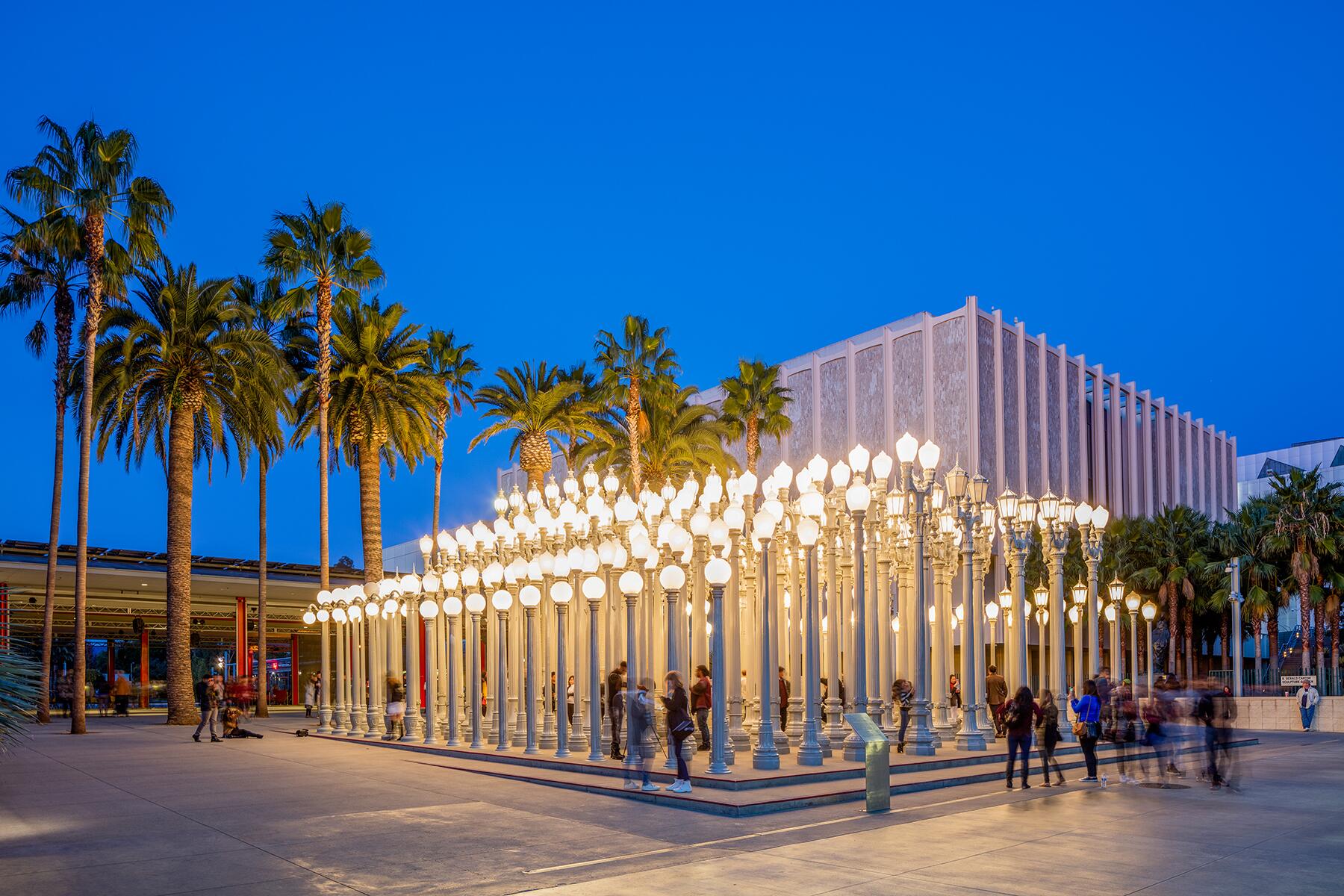
If your past travel experience in Germany has been limited to a few days in Berlin or perhaps a layover at the airport in Frankfurt, you’ve got some exploring to do. Located in the southeast, Bavaria (“Bayern” in German) occupies almost one-fifth of the country’s total land area; is the second-most populous state in the Federal Republic of Germany, with more than twelve million inhabitants; and is home to the country’s third-largest city, Munich, which serves as Bavaria’s capital. Whether you know it or not, what Americans often regard as German culture—lederhosen, beer gardens, oom-pah music—is actually Bavarian culture. But the state’s unique regional identity isn’t the only thing worth experiencing here—there are awe-inspiring castles, storybook medieval towns, green vineyards, towering mountains, and so much more.
By Michael Alan Connelly
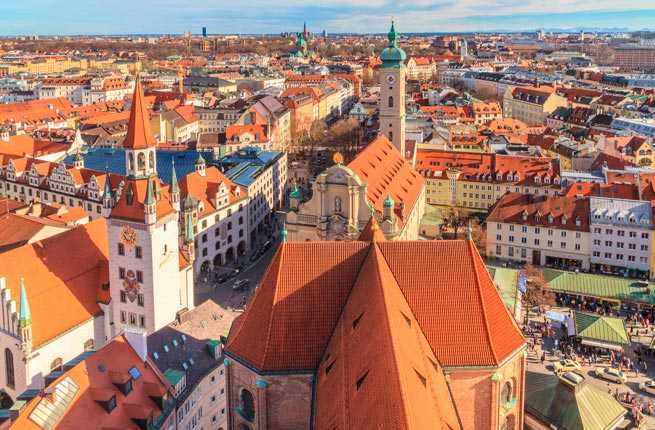
Munich
Munich is internationally known for Oktoberfest, the sixteen-day fair celebrating Bavarian beer and food, which has been held annually since 1810 and attracts more than six million visitors from around the world. Still, there’s a lot more to uncover in this wealthy city, from bustling Marienplatz to the iconic towers of the Frauenkirche. Other highlights include al fresco dining at the Viktualienmarkt, the splendid grounds of the baroque and rococo Schloss Nymphenburg, automotive thrills at BMW World, high-end shops on Maximilianstrasse, modern art at the Neue Pinakothek, and the royal Residenz.
On a more serious note, the city is now home to the Munich Documentation Center for the History of National Socialism—there was a deliberate choice not to call it a “museum”—which opened in May and provides an extensive history of the Nazis. Following decades of denying its role in Hitler’s rise to power, Munich is now embracing the facts, which is a positive development for both the city and the country.
PLAN YOUR TRIP: Visit Fodor’s Munich Travel Guide
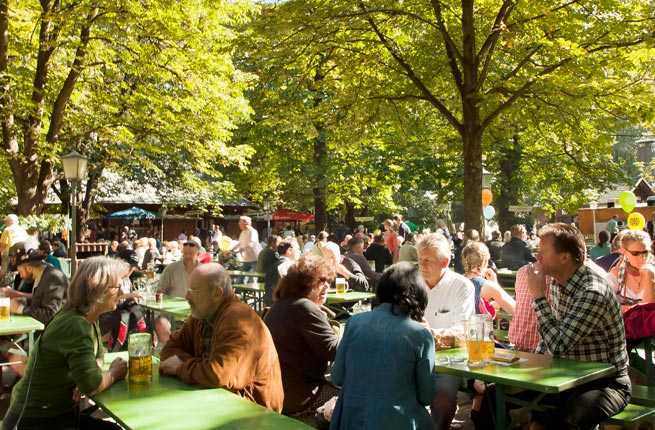
German Beer
Of course, you can’t go to Bavaria without drinking German beer, and Munich is an excellent place to do exactly that. One of the main reasons beer is so prized here is a 1516 law, sometimes called the German Beer Purity Law, which dictated that beer produced here could only contain three ingredients: water, malt, and hops (yeast had not been discovered yet but was indeed an unknown fourth ingredient). Aside from standing as what is believed to be the world’s first food-production law, the statute created a culture in which a high-quality product was not only prized, but also widely available.
Apart from Oktoberfest, the Beer and Oktoberfest Museum offers a look at the festival’s origins, and you can also tour the facilities of legendary producers such as Paulaner, which has been making brews since 1634. On the flip side, don’t miss a chance to see how the city’s smaller producers are changing the beer scene. Giesinger Bräu is just one example of a relative newcomer that’s offering something fresh in what is a very traditional industry. If nothing else, treat yourself to a meal in one of Munich’s famous beer gardens or restaurants—Augustiner Keller should be at the top of your list.
PLAN YOUR TRIP: Visit Fodor’s Munich Travel Guide
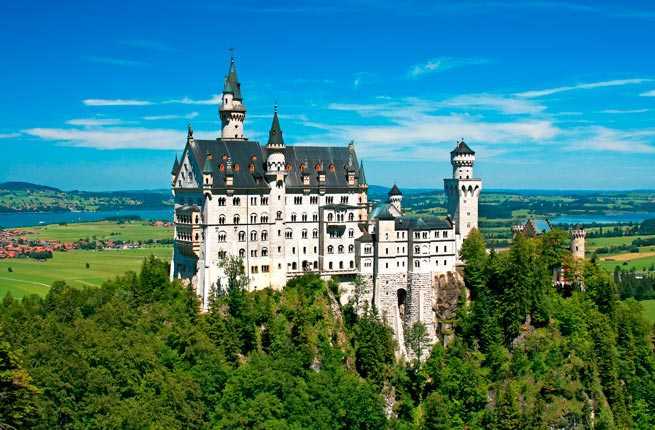
Neuschwanstein Castle
Just over ninety minutes’ driving time southwest of Munich sits one of Germany’s top tourist attractions, Neuschwanstein. This iconic castle is often cited as Walt Disney’s inspiration for the one that appeared in Sleeping Beauty and later the Disneyland castle itself. Dreamt up by “crazy” King Ludwig II, this over-the-top castle never served as his primary residence, and the interiors are technically unfinished, even after seventeen years of work, which ceased when the king died mysteriously. For example, the Byzantine-style throne room has no throne. Still, the castle is magnificent, but note that you can only enter as part of a timed guided tour, one that moves at a fairly brisk pace, thanks to the number of visitors who flock here daily.
Indeed, you may find the view from the outside to be better than what you see inside; for the best vantage point, walk up to the Marienbrücke, a bridge that spans a deep, narrow gorge. Inside, near the end of the tour, be sure to step out onto the terrace near the gift shop, as it affords stunning views of the mountains and surrounding countryside. And as with all tourist attractions that draw international crowds, the earlier you arrive in the day, the better.
PLAN YOUR TRIP: Visit Fodor’s The Romantic Road Travel Guide

Garmisch-Partenkirchen
Once two separate towns, Garmisch and Partenkirchen became one to host the 1936 Winter Olympics. Today, it’s a year-round resort and spa town, though winter sports are the main sell here, with no shortage of downhill and cross-country ski trails in the area. No matter what time of year, you can go on guided tours of the Olympic Ski Jump or ice-skate in the Olympic Ice Sports Center, though the biggest draw of the town is the Zugspitze, Germany’s tallest mountain at 9,717 feet. You can take a cable car to the summit and dine there or, for a newer thrill, walk out onto the AlpspiX, an observation terrace made of two steel beams that extend over the Höllental Valley, with a vertical drop of more than 3,000 feet.
If you feel like exploring the town, Partenkirchen is the more charming, less congested of the two areas, though you’ll find eye-catching, pastel-hued frescoes adorning the facades of buildings no matter where you are.
PLAN YOUR TRIP: Visit Fodor’s The Bavarian Alps Travel Guide
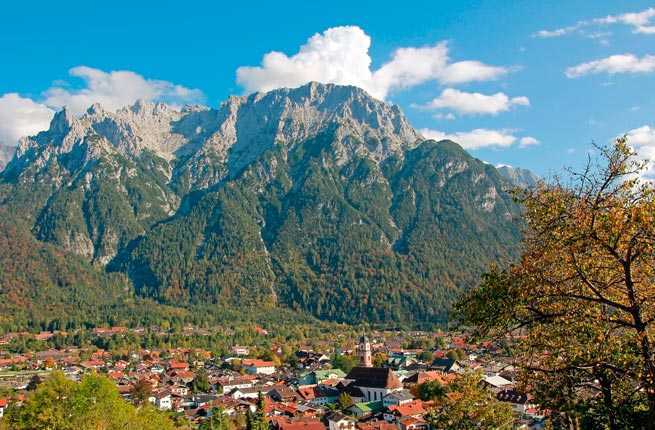
Mittenwald
Widely regarded as the most beautiful town in the Bavarian Alps, Mittenwald was once described as “a picture book come alive” by Goethe himself, but the sentiment rings true even today. Aside from its aesthetic charms, Mittenwald is home to a robust history of violin making, which you can learn all about at The Geigenbaumuseum. From there, you’ll be directed to one of several local violin makers who maintain the town tradition. If the weather is pleasant, it’s worth hitting the relatively easy trail—it takes less than an hour—from Mittenwald to the stunning alpine lake Lautersee.
When you’re done with the hike, head to the lakeside restaurant for beer or espresso paired with a view of the Wetterstein, the chain of mountains that encompasses the Zugspitze. Not far from Mittenwald lies Schloss Elmau, an expansive luxury retreat that hosted President Obama and other world leaders during the G7 summit in June 2015.
PLAN YOUR TRIP: Visit Fodor’s Fodor’s The Bavarian Alps Travel Guide
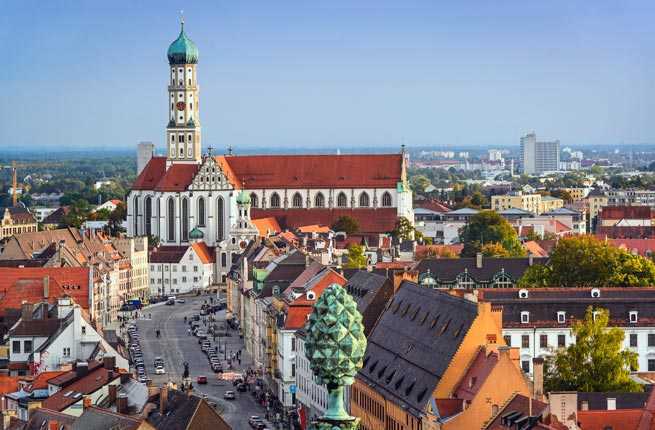
Augsburg
One of the main reasons Bavaria has a cultural identity that diverges from other parts of Germany is that it was formerly a duchy in the Middle Ages and later a kingdom after Napoleon abolished the Holy Roman Empire. In 1815, Bavaria was allowed to annex neighboring areas with different histories and customs, including regions that make up the state of Bavaria to this day. For this reason, you can technically be in Bavaria while feeling that you have entered another region altogether: Locals gravitate to wine instead of beer, the cuisine is lighter, and the architecture is different.
You’ll experience this feeling in Augsburg, which was founded by the Romans in 15 B.C. and is one of the stops on Germany’s so-called Romantic Road. The third-largest city in Bavaria, Augsburg has several noteworthy attractions, including the Fuggerei, the world’s oldest social housing project, opened in 1516 and still in operation today; Brechthaus, the birthplace of playwright Bertolt Brecht; the Dom St. Maria, which features architectural elements from the ninth through fourteenth centuries; and the Rathaus, which was almost completely destroyed during World War II but completed a full restoration in the mid-1980s—its Golden Hall is a must-see.
PLAN YOUR TRIP: Visit Fodor’s The Romantic Road Travel Guide

Rothenburg ob der Tauber
Like a storybook medieval town come to life, Rothenburg ob der Tauber is almost unbelievably picturesque, with half-timber architecture, fountains, towers, and turrets on display wherever you look. It’s something of a tourist trap these days, but it’s lovely if you can overlook that fact. A view from the top of the Rathaus’s tower gives a good lay of the land; you’ll see that half of the town is Gothic, and the other half neoclassical.
For something rather different, a trip to the Medieval Criminal Museum may be in order for a surprisingly fascinating look at crime and punishment in less enlightened times. Be sure to stop into a bakery for a taste of Schneeballen (“snowballs”). Rothenburg is also home to Käthe Wohlfahrt, the famous Christmas store where you can buy ornaments, nutcrackers, and much more all year long. Your best bet for lodging is the Hotel Eisenhut, whose seventy-nine rooms feature individual color schemes and antique furniture; ask for a room up top near the back to enjoy wonderful views of the Tauber River valley and the Old Town.
PLAN YOUR TRIP: Visit Fodor’s The Romantic Road Travel Guide
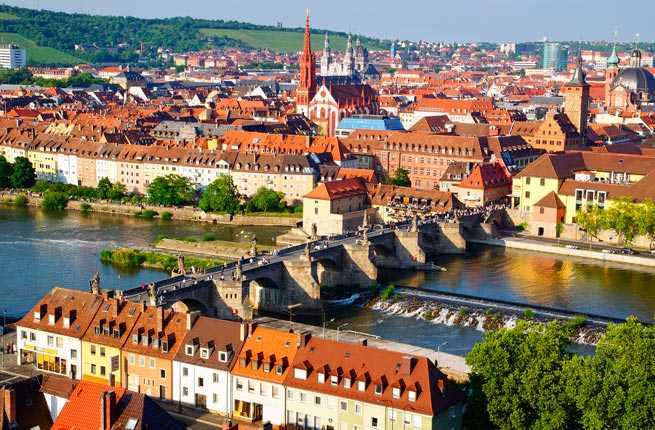
Wurzburg
The Würzburg you’ll see today isn’t quite the original thing—nearly 90 percent of it was destroyed during a bombing raid seven weeks before the end of World War II. Considering all that, it’s amazing how the city rebounded and restored its landmarks to their former glory. The star attraction in town is the royal Residenz, a dazzling baroque palace that is considered one of the best in Europe and registered as a UNESCO World Heritage Site.
Elsewhere, a visit to the Museum im Kulturspeicher is worth a visit, particularly for the Peter C. Ruppert Collection of postwar art made by artists from twenty-three European nations. After your visit, have a drink outside on the River Main and admire the vineyards on the other side. If the weather is pleasant, join the post-work socializing that takes over the Old Main Bridge, where locals convene for wine, snacks, gossip, and people watching. For dinner, you’d be hard-pressed to find a better option than Backöfele, a somewhat-hidden old tavern with hundreds of years of history.
PLAN YOUR TRIP: Visit Fodor’s The Romantic Road Travel Guide
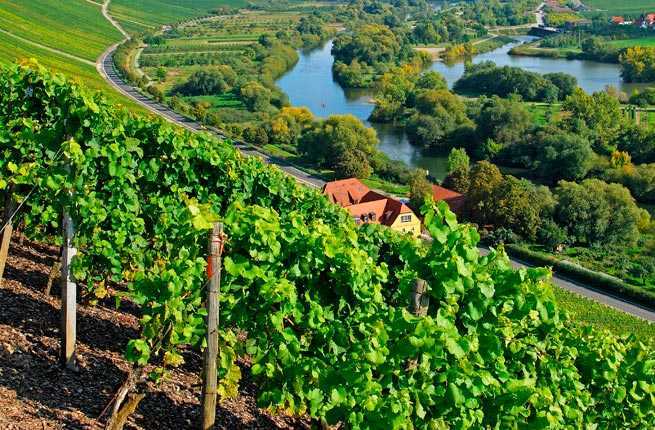
German Wine
You can visit vineyards in the countryside if you like, but wine lovers can enjoy some unique experiences without leaving town. In Rothenburg, make time for a tasting of locally produced Franconian wines at Glocke Winery, where you can also eat dinner or stay overnight.
In Würzburg, your top priority should be visiting the Juliusspital, a hospital that also, surprisingly, houses the largest wine estate in Germany. Wander through the park and grounds before going on a cellar tour and tasting, which includes six half-glasses aged in barrels on site.
PLAN YOUR TRIP: Visit Fodor’s The Romantic Road Travel Guide
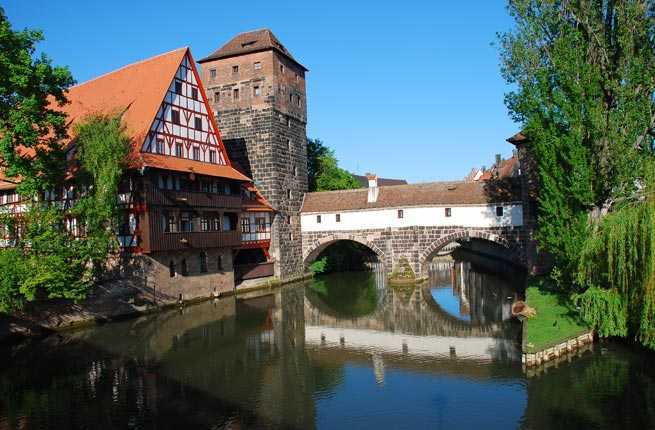
Nuremberg
Though you likely know it as Nuremberg, this city is in fact called Nürnberg, and it’s one of the most historic places in Germany, with a recorded history stretching back to 1050. For war buffs, this was where Hitler staged some of his most grandiose Nazi rallies and later, fittingly, where the Allies held their war trials.
At least 90 percent of the Old Town was destroyed during the war, so it’s a miracle to see it fully rebuilt today in all its former splendor. There are a number of museums to appeal to different interests, and if the season is right, the Hauptmarkt hosts one of Europe’s best Christmas markets.
PLAN YOUR TRIP: Visit Fodor’s Franconia and the German Danube Travel Guide

